2002 MERCEDES-BENZ S500 level
[x] Cancel search: levelPage 346 of 430
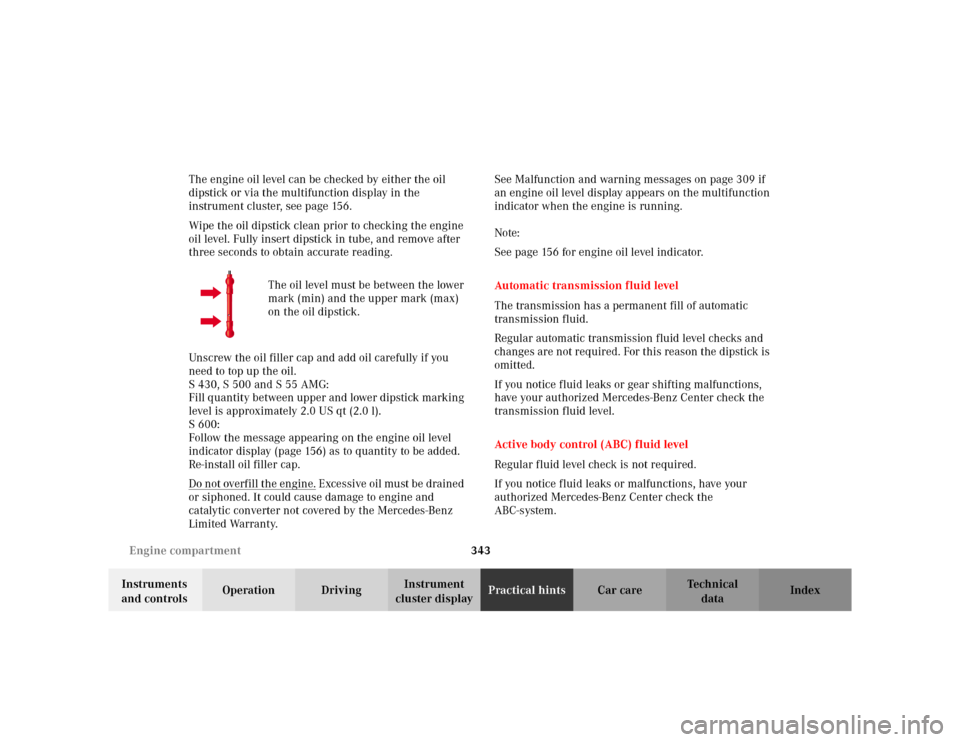
343 Engine compartment
Te ch n i c a l
data Instruments
and controlsOperation DrivingInstrument
cluster displayPractical hintsCar care Index The engine oil level can be checked by either the oil
dipstick or via the multifunction display in the
instrument cluster, see page 156.
Wipe the oil dipstick clean prior to checking the engine
oil level. Fully insert dipstick in tube, and remove after
three seconds to obtain accurate reading.
The oil level must be between the lower
mark (min) and the upper mark (max)
on the oil dipstick.
Unscrew the oil filler cap and add oil carefully if you
need to top up the oil.
S 430, S 500 and S 55 AMG:
Fill quantity between upper and lower dipstick marking
level is approximately 2.0 US qt (2.0 l).
S 600:
Follow the message appearing on the engine oil level
indicator display (page 156) as to quantity to be added.
Re-install oil filler cap.
Do not overfill the engine.
Excessive oil must be drained
or siphoned. It could cause damage to engine and
catalytic converter not covered by the Mercedes-Benz
Limited Warranty.See Malfunction and warning messages on page 309 if
an engine oil level display appears on the multifunction
indicator when the engine is running.
Note:
See page 156 for engine oil level indicator.
Automatic transmission fluid level
The transmission has a permanent fill of automatic
transmission fluid.
Regular automatic transmission fluid level checks and
changes are not required. For this reason the dipstick is
omitted.
If you notice fluid leaks or gear shifting malfunctions,
have your authorized Mercedes-Benz Center check the
transmission fluid level.
Active body control (ABC) fluid level
Regular fluid level check is not required.
If you notice fluid leaks or malfunctions, have your
authorized Mercedes-Benz Center check the
ABC-system.
Page 347 of 430
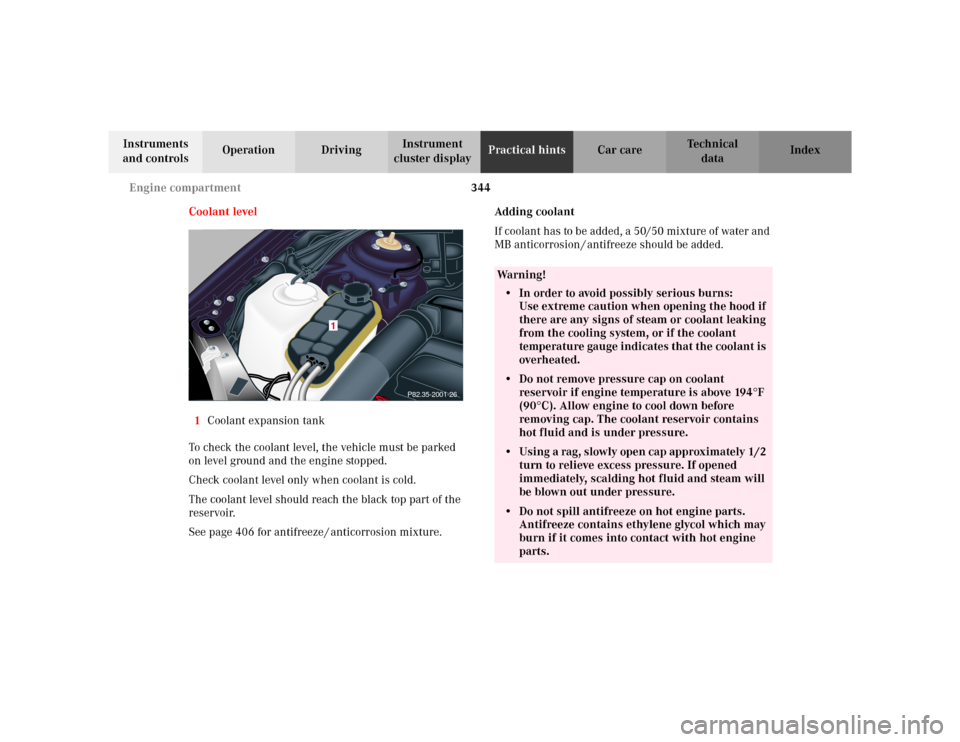
344 Engine compartment
Te ch n i c a l
data Instruments
and controlsOperation DrivingInstrument
cluster displayPractical hintsCar care Index
Coolant level
1Coolant expansion tank
To check the coolant level, the vehicle must be parked
on level ground and the engine stopped.
Check coolant level only when coolant is cold.
The coolant level should reach the black top part of the
reservoir.
See page 406 for antifreeze / anticorrosion mixture.Adding coolant
If coolant has to be added, a 50/50 mixture of water and
MB anticorrosion / antifreeze should be added.
P82.35-2001-26
1
Wa r n i n g !
• In order to avoid possibly serious burns:
Use extreme caution when opening the hood if
there are any signs of steam or coolant leaking
from the cooling system, or if the coolant
temperature gauge indicates that the coolant is
overheated.• Do not remove pressure cap on coolant
reservoir if engine temperature is above 194
°F
(90
°C). Allow engine to cool down before
removing cap. The coolant reservoir contains
hot fluid and is under pressure.
• Using a rag, slowly open cap approximately 1/2
turn to relieve excess pressure. If opened
immediately, scalding hot fluid and steam will
be blown out under pressure.• Do not spill antifreeze on hot engine parts.
Antifreeze contains ethylene glycol which may
burn if it comes into contact with hot engine
parts.
Page 350 of 430
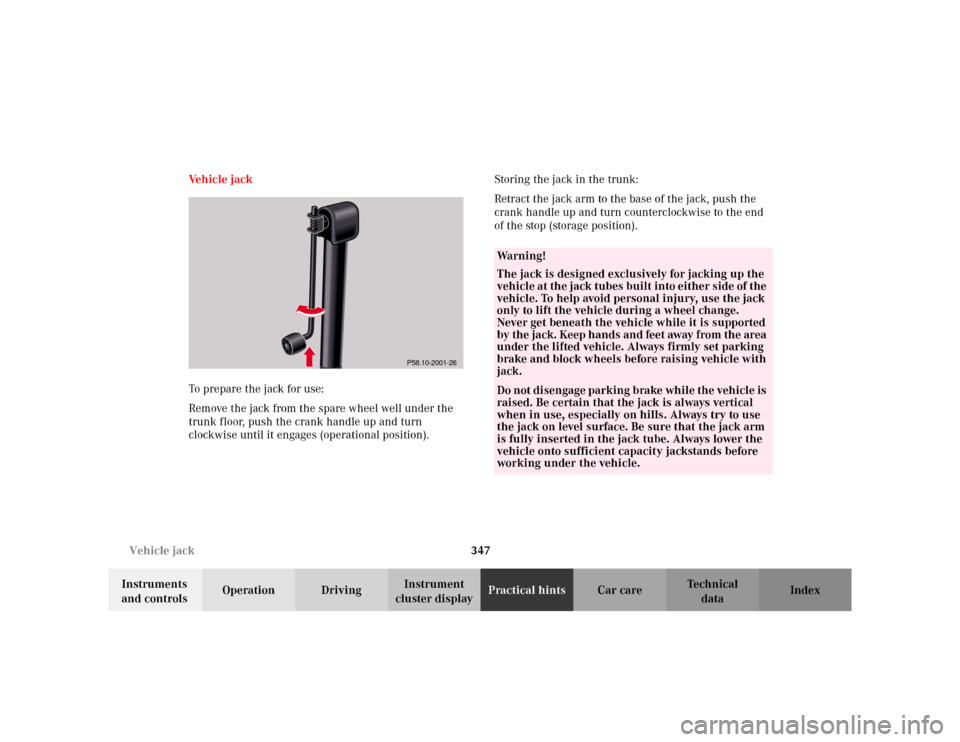
347 Vehicle jack
Te ch n i c a l
data Instruments
and controlsOperation DrivingInstrument
cluster displayPractical hintsCar care Index Ve h i c l e j a c k
To prepare the jack for use:
Remove the jack from the spare wheel well under the
trunk floor, push the crank handle up and turn
clockwise until it engages (operational position).Storing the jack in the trunk:
Retract the jack arm to the base of the jack, push the
crank handle up and turn counterclockwise to the end
of the stop (storage position).
P58.10-2001-26
Wa r n i n g !
The jack is designed exclusively for jacking up the
vehicle at the jack tubes built into either side of the
vehicle. To help avoid personal injury, use the jack
only to lift the vehicle during a wheel change.
Never get beneath the vehicle while it is supported
by the jack. Keep hands and feet away from the area
under the lifted vehicle. Always firmly set parking
brake and block wheels before raising vehicle with
jack.Do not disengage parking brake while the vehicle is
raised. Be certain that the jack is always vertical
when in use, especially on hills. Always try to use
the jack on level surface. Be sure that the jack arm
is fully inserted in the jack tube. Always lower the
vehicle onto sufficient capacity jackstands before
working under the vehicle.
Page 354 of 430
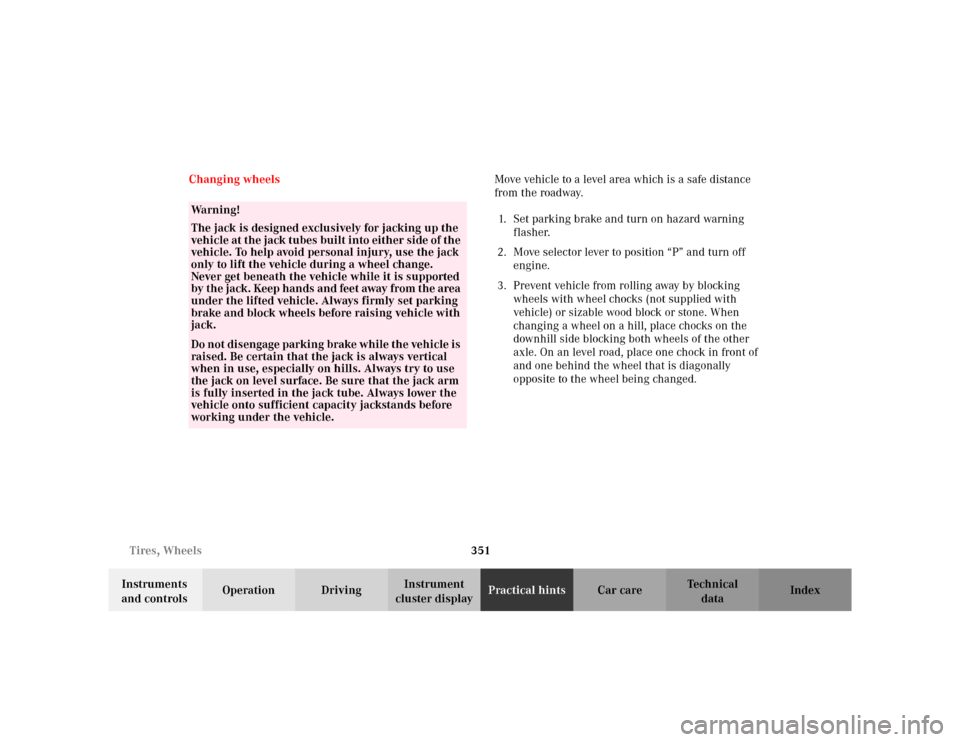
351 Tires, Wheels
Te ch n i c a l
data Instruments
and controlsOperation DrivingInstrument
cluster displayPractical hintsCar care Index Changing wheelsMove vehicle to a level area which is a safe distance
from the roadway.
1. Set parking brake and turn on hazard warning
flasher.
2. Move selector lever to position “P” and turn off
engine.
3. Prevent vehicle from rolling away by blocking
wheels with wheel chocks (not supplied with
vehicle) or sizable wood block or stone. When
changing a wheel on a hill, place chocks on the
downhill side blocking both wheels of the other
axle. On an level road, place one chock in front of
and one behind the wheel that is diagonally
opposite to the wheel being changed.
Wa r n i n g !
The jack is designed exclusively for jacking up the
vehicle at the jack tubes built into either side of the
vehicle. To help avoid personal injury, use the jack
only to lift the vehicle during a wheel change.
Never get beneath the vehicle while it is supported
by the jack. Keep hands and feet away from the area
under the lifted vehicle. Always firmly set parking
brake and block wheels before raising vehicle with
jack.Do not disengage parking brake while the vehicle is
raised. Be certain that the jack is always vertical
when in use, especially on hills. Always try to use
the jack on level surface. Be sure that the jack arm
is fully inserted in the jack tube. Always lower the
vehicle onto sufficient capacity jackstands before
working under the vehicle.
Page 410 of 430
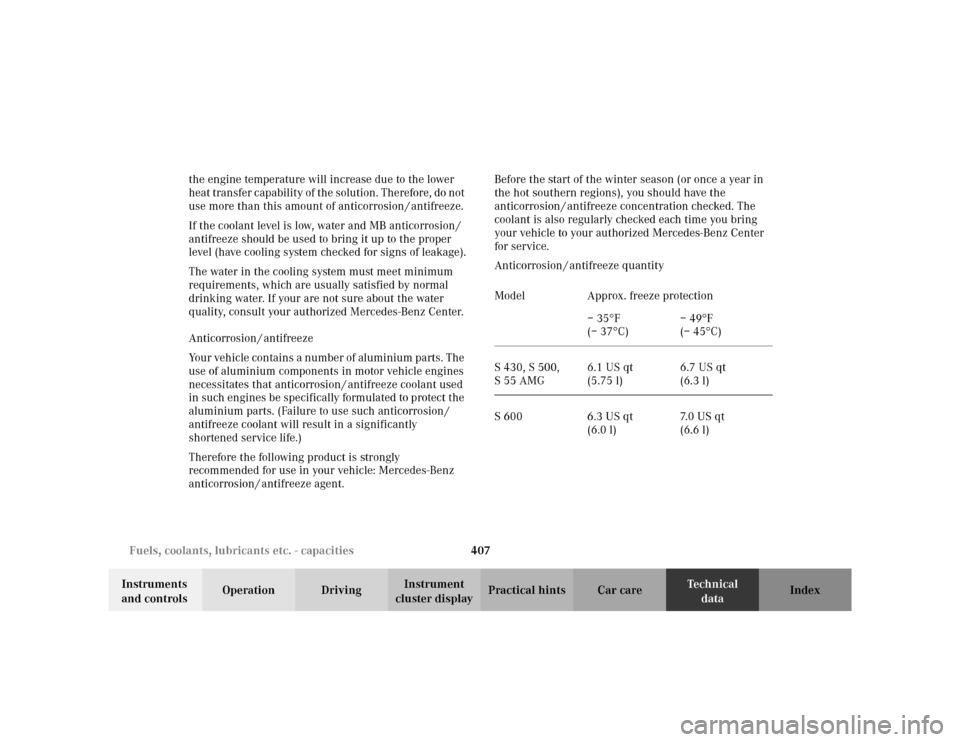
407 Fuels, coolants, lubricants etc. - capacities
Te ch n i c a l
data Instruments
and controlsOperation DrivingInstrument
cluster displayPractical hints Car care Index the engine temperature will increase due to the lower
heat transfer capability of the solution. Therefore, do not
use more than this amount of anticorrosion / antifreeze.
If the coolant level is low, water and MB anticorrosion /
antifreeze should be used to bring it up to the proper
level (have cooling system checked for signs of leakage).
The water in the cooling system must meet minimum
requirements, which are usually satisfied by normal
drinking water. If your are not sure about the water
quality, consult your authorized Mercedes-Benz Center.
Anticorrosion / antifreeze
Your vehicle contains a number of aluminium parts. The
use of aluminium components in motor vehicle engines
necessitates that anticorrosion / antifreeze coolant used
in such engines be specifically formulated to protect the
aluminium parts. (Failure to use such anticorrosion /
antifreeze coolant will result in a significantly
shortened service life.)
Therefore the following product is strongly
recommended for use in your vehicle: Mercedes-Benz
anticorrosion / antifreeze agent.Before the start of the winter season (or once a year in
the hot southern regions), you should have the
anticorrosion / antifreeze concentration checked. The
coolant is also regularly checked each time you bring
your vehicle to your authorized Mercedes-Benz Center
for service.
Anticorrosion / antifreeze quantity
Model Approx. freeze protection
– 35
°F
(– 37°C)– 49
°F
(– 45°C)
S 430, S 500,
S 55 AMG6.1 US qt
(5.75 l)6.7 US qt
(6.3 l)
S 600 6.3 US qt
(6.0 l)7. 0 U S q t
(6.6 l)
Page 412 of 430
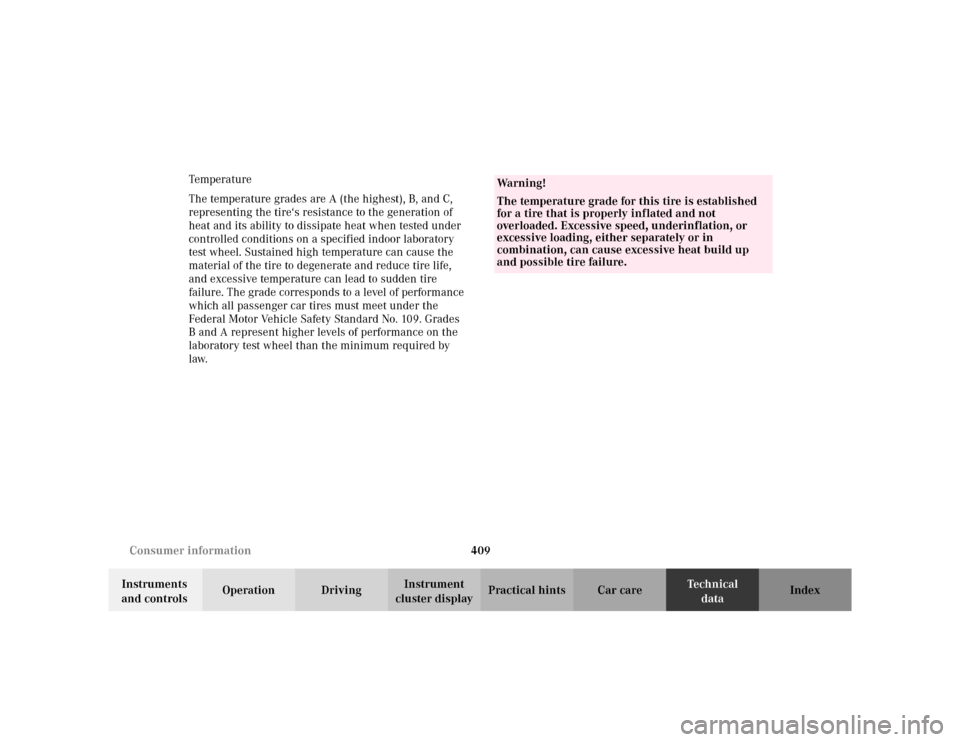
409 Consumer information
Te ch n i c a l
data Instruments
and controlsOperation DrivingInstrument
cluster displayPractical hints Car care Index Tempera t u re
The temperature grades are A (the highest), B, and C,
representing the tire‘s resistance to the generation of
heat and its ability to dissipate heat when tested under
controlled conditions on a specified indoor laboratory
test wheel. Sustained high temperature can cause the
material of the tire to degenerate and reduce tire life,
and excessive temperature can lead to sudden tire
failure. The grade corresponds to a level of performance
which all passenger car tires must meet under the
Federal Motor Vehicle Safety Standard No. 109. Grades
B and A represent higher levels of performance on the
laboratory test wheel than the minimum required by
law.
Wa r n i n g !
The temperature grade for this tire is established
for a tire that is properly inflated and not
overloaded. Excessive speed, underinflation, or
excessive loading, either separately or in
combination, can cause excessive heat build up
and possible tire failure.
Page 413 of 430

410 Index
Te ch n i c a l
data Instruments
and controlsOperation DrivingInstrument
cluster displayPractical hints Car careIndex
Index
AABS (Antilock brake system) .......................................278
Malfunction indicator lamp ..................................... 306
Active body control (ABC) ............................................ 284
Fluid level ...................................................................343
ACTIVE BODY CONTROL (A BC) -
malfunction and warning messages ......................320
Adaptive damping system (ADS) .................................289
Adjusting steering wheel .............................................. 102
AIR CLEANER -
malfunction and warning messages ......................333
Air conditioner refrigerant ........................................... 404
Air distribution, manual ............................................... 172
Air volume, manual ....................................................... 172
Airbag deactivation system ............................................ 88
AIRBAG OFF indicator lamp ........................................308
Airbags .............................................................................. 91
AIRMATIC -
malfunction and warning messages ...................... 331
Airmatic system ............................................................. 285
Airmatic system
(Vehicles with Active Body Control) ......................286Alarm system ............................................................. 60, 61
Anticorrosion/antifreeze ...................255, 344, 402, 406
Antilock brake system (ABS) ...................................... 278
Malfunction indicator lamp .................................... 306
Antitheft alarm system ...................................................60
Aquaplaning .................................................................. 252
Armrest, rear seat ..........................................................201
Ashtrays .......................................................................... 204
Center console .......................................................... 204
Rear doors ................................................................. 205
Audio systems ................................................................. 124
Cassette player .......................................................... 126
CD Player ....................................................................125
Radio ...........................................................................124
Automatic central locking .............................................. 50
Automatic climate control ............................................ 166
Activated charcoal filter ........................................... 175
Adjustable air outlets,
rear passenger compartment ............................. 179
Air distribution, manual .......................................... 172
Air volume, manual .................................................. 172
Basic setting ............................................................... 171
Defogging windows ................................................... 173
Defrosting ................................................................... 173
Display and controls ................................................. 168
Dust filter ................................................................... 170
Page 414 of 430

411 Index
Te ch n i c a l
data Instruments
and controlsOperation DrivingInstrument
cluster displayPractical hints Car careIndex Economy mode ...........................................................176
Front center console
storage compartment ventilation ...................... 178
MAXCOOL .......................................................... 170, 181
Rear window defroster ............................................. 183
Residual engine heat utilization (REST) ................176
Special settings ......................................................... 172
Switching on and off ................................................ 177
Automatic climate control, rear
Air volume, manual .................................................. 181
Basic setting .............................................................. 181
Automatic maximum cooling ....................................... 170
Rear passenger compartment climate control ..... 181
Automatic transmission ...............................................237
Emergency operation ...............................................245
Fluid level ...................................................................343
Program mode selector switch ............................... 244
Selector lever position ..............................................240
BBabySmart
TM airbag deactivation system ..................... 88
Self-test ......................................................................... 88
BAS (Brake assist system) ............................................ 277
Battery .............................................................................357Battery recycling ...................................................... 358
BATTERY / ALTERNATOR -
malfunction and warning messages ...................... 311
Block heater ................................................................... 255
BRAKE ASSIST -
malfunction and warning messages ...................... 312
Brake assist system (BAS) ........................................... 277
Brake fluid .................................. 248, 299, 304, 402, 404
BRAKE FLUID -
malfunction and warning messages ...................... 313
Brake pad wear ............................................................... 313
BRAKE PAD WEAR -
malfunction and warning messages ...................... 313
Brake warning lamp ..................................................... 304
Brake fluid low ......................................................... 304
Brakes .......................................... 246, 248, 277, 278, 280
Bulbs
See Replacing bulbs ................................................. 364
CCapacities
Fuels, coolants, lubricants etc. .............................. 402
Card, KEYLESS-GO ..........................................................28
Catalytic converter ........................................................ 228
Center console .................................................................. 24